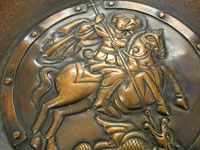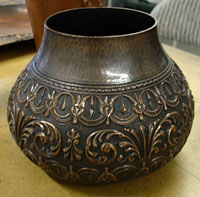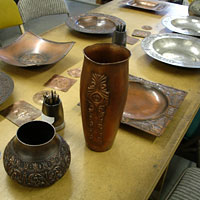Valentin Yotkov: Continuing the Master Craft of Repoussé
 Valentin working in his studio.
Valentin working in his studio. Courtesy of Valentin Yotkov
When he was 20, however, an opportunity came his way, and Yotkov jumped at the chance to work for a metal artist. After just four months, he was told that he should apprentice with a master. That master turned out to be Alexander Raiev, then about 70 years old.
"He was an amazing person," Yotkov says. "He was very knowledgeable. He knew about everything and anything…It was like learning not only the craft and how to work the metal, but all these little things about life and people and friendship. It was a really great time." Yotkov's website includes an homage to his teacher, and he named his son after Raiev. Today, Yotkov owns his own studio and school in Brooklyn, New York.
Becoming a master was a nerve-wracking process for Yotkov, but he reached that distinction much faster and younger than most. Raiev recognized Yotkov's talents early and decided that he was ready to apply to become a master after just eight months as an apprentice. (Most metal artists apprenticed with a master for at least a year or two.) In 1980, Yotkov presented six pieces of his work to a panel of masters, and they decided that he was eligible to apply for master status.
"It was the scariest moment of my life," Yotkov recalls. "You have to work for three days in front of a panel of old masters, and they have their round spectacles on their ears, and they watch you and scrutinize every movement…I don't remember one minute of those three days. I was so consumed, and I tried so hard to impress them that the only thing I remember was when my teacher at the end came to me, shook my hand, and said, 'Congratulations.'" Raiev then gave Yotkov an antique hammer that had been handed down to Raiev by his own teacher years before.
 Detail view of one of Valentin's vessels.
Detail view of one of Valentin's vessels. Photograph by Paul David
Yotkov's favorite patina is from a recipe created by Raiev. Unfortunately, the formula is lost because Yotkov was so young during his apprenticeship that it never dawned on him to ask his teacher for the ingredients.
"It gave the impression of some light glowing from inside your piece," Yotkov says of the patina. "It looks like you have plugged the piece into the outlet, and somehow, this warm reddish, brownish, ochre color light comes out of it. It's almost like you see water in this color, and you can put your fingers in that water. This is how transparent it is. It's killing me that in this modern society, we have lost so much of this knowledge - all of these little tricks and tips…I always say that the people who know the little tips and tricks rule the world."
Yotkov has never found another recipe that comes close to this patina developed by his master teacher. Raiev once said that the formula included bull urine and insisted he wasn't joking, but no one will ever know if it was true.
While Raiev worked primarily in copper and was a master at raising vessels, it was a more intricate technique that truly ignited Yotkov's interest.
"I saw one of those gold treasures that some Thracian goldsmith created 2500 to 2600 years ago, and I thought it was really fascinating. It was amazing to see what can be done with metal. I guess I fell in love with chasing and repoussé," he says. With these ancient techniques, Yotkov says, "you can go down to the finest detail. There is almost no limit to how small you can go."
 A completed vessel.
A completed vessel. Photograph by Paul David
Yotkov developed his chasing and repoussé technique through a combination of trial and error and the painstaking study of museum pieces. The three-part process, which sculpts the metal, begins by chasing the design on the front of the metal using straight and curved liners. Then, the relief is raised directly in the metal by pushing from the back with small tools of different shapes and sizes called "punches." The metal is then annealed and placed face up in the pitch, so that the chasing detail can be finished on the front. Essentially, the artist shapes the metal by moving part of it from one spot to another.
"It's a very delicate technique," Yotkov stresses. "It requires a lot of dedication, a lot of patience, a lot of devotion, and the final result is really amazing."
While chasing and repoussé were practiced in many ancient cultures, Yotkov believes it was the Thracians who took the technique to the highest level. "I believe they created some of the most beautiful pieces ever made by human hands," he says. Because Bulgaria is located in the crossroad between Asia and Europe, many of the golden treasures of the Thracians, as well as the Greeks, Romans, Turks, and Ottomans, were stored there. New pieces are frequently discovered in the country, and it is believed that only a fraction of the treasures have been found.
Yotkov joined two archaeological expeditions in Bulgaria in order to be closer to the pieces he wanted to study. While they didn't find any gold artifacts during the excavations, he made enough connections that he was given access to some of the gold pieces in the museum. "I pressed bits of Plasticine into the impressions to see what tools the ancient masters used, and I tried to recreate those tools," he says. The result was a basic chasing and repoussé tool set that he developed, which consists of 13 shapes with three sizes of each shape. "These tools are so uniform, so universal," he says, "and they work so well together that you can switch from one shape to another shape without showing your work…. I basically had to learn all of this on my own. Now, when I teach classes in a week, people learn what it took me years and years to figure out." He is quick to point out, however, that no one can become a master in a week.
"If a person comes to my class, they will learn absolutely everything I know," he says, "whether it's the basic level, intermediate level, or advanced level…. But perfection takes years."
When Yotkov tried to replicate his first ancient piece from a museum, he placed his work next to the original and found that his was lacking. "I was getting really frustrated," he says. Just when he had lost hope of ever figuring out how to duplicate the beauty of the original, "a sign from God" arrived. "Suddenly, one of the lights went out while I was staring at a golden vessel," he recalls. With only one light illuminating the vessel, he saw a slight vertical edging like a wall around each raised design, which separated it further from the background. "I rushed home. I took my tools, and in a half hour, one hour, that was it," he says. "I was able to figure out what was missing in my work. So, now, I tell all my students, 'If there is one thing you want to learn from me about repoussé, it is that edging, that raising an extra bit.'"
 An array of works rests on the worktable in Valentin's studio.
An array of works rests on the worktable in Valentin's studio. Photograph by Paul David
Yotkov moved through the ranks of metal artists in Bulgaria exceptionally fast. In 1983, at the tender age of 23, he was elected President of the National Silversmith Guild. So much for "old" masters. In that role, he was able to travel to various countries to meet with other masters. In 1990, an invitation arrived to participate in a competition at a New York City gallery. Coming to the United States had long been one of his dreams, and even though he didn't speak English, he carried a secret with him to New York: He was not planning to return to Bulgaria.
"I came to this country with $5 in my pocket, and I've survived almost 20 years doing this," Yotkov says. In order to obtain his entry visa, he had to have a sponsor in the U.S. who took responsibility for his financial needs during his stay. After a few weeks with his sponsor, he filed immigration papers, received a work permit, and began working at a foundry in Brooklyn. He was shocked that people in New York were unfamiliar with chasing and repoussé. When he told people that he was a chaser, they asked, "Who are you chasing?" He was saddened by this and determined to revive the beautiful old world art.
Luckily, the Bulgarian government had allowed Yotkov to bring all of his works to the U.S. with him, and this helped to open some doors. "I had three dreams," he says. "One was to work for the Metropolitan Museum of Art. The other one was to work for Tiffany, and the third one was to teach - to open a school." In 1992, two years after arriving in New York, he gave his first chasing and repoussé demonstration at the American Craft Museum. It wasn't long before someone at the Met became interested in his work and tried to arrange to hire him, but it never worked out. Tiffany wanted to hire him as well but told him he was overqualified for the job. He decided they were right and continued to follow his own creative path.
By 1994, Yotkov had managed to put enough money aside to realize his third dream - opening his own school and studio. "My studio is now recognized as the only school in the United States that specializes in chasing and repoussé techniques," he says proudly. It began as a vessel raising studio, but with 10-12 students hammering at the same time, Yotkov's hearing was adversely affected. After about six years, he shifted his focus to repoussé jewelry, which few others produce today. One of his current passions is showing people how this technique can be used to create exquisite one-of-a-kind jewelry pieces.
Interest in raising, as well as chasing and repoussé, continues to increase, and this interest has resulted in about 1600 students for Yotkov over the years. He teaches in his Brooklyn studio and in Europe, and he has had invitations for workshops in Canada, Australia, and Argentina.
Yotkov has exhibited all over the world and has won countless awards. Sixty to 65% of his work is in copper, while 30-35% is in silver. "I love the warm color of copper," he says. If he's unhappy with a piece, however, he may not even try to sell it. "If it's not good enough to be sold or no one wants to buy it, I won't even sign it," he says. The market for these one-of-a-kind pieces is narrow, but people who appreciate the artistry are willing to pay for it. According to Yotkov, the most expensive pieces sold at auction houses like Sotheby's usually contain some repoussé work.
"When I came to this country, I found out that the American people are so supportive, so giving, so helping," Yotkov says. "I have received a lot of help, including financial help. This is why I kept teaching for so many years. This was the only way I could give back. It's also my passion and love for this art, and I don't want it to die."
Resources:
Valentin Yotkov Studio, 68 Jay St., Suite 501A, Brooklyn, NY, (718) 852-8640
Also in this Issue:
- Valentin Yotkov: Continuing the Master Craft of Repoussé
- UB Arts Sheds New Light on Reclaimed Copper
- Miel-Margarita Paredes Imaginatively Reinterprets Our World
- Time is the Essence: American Clock & Watch Museum
- Cast in Bronze: French Sculpture from Renaissance to Revolution on View at Met
